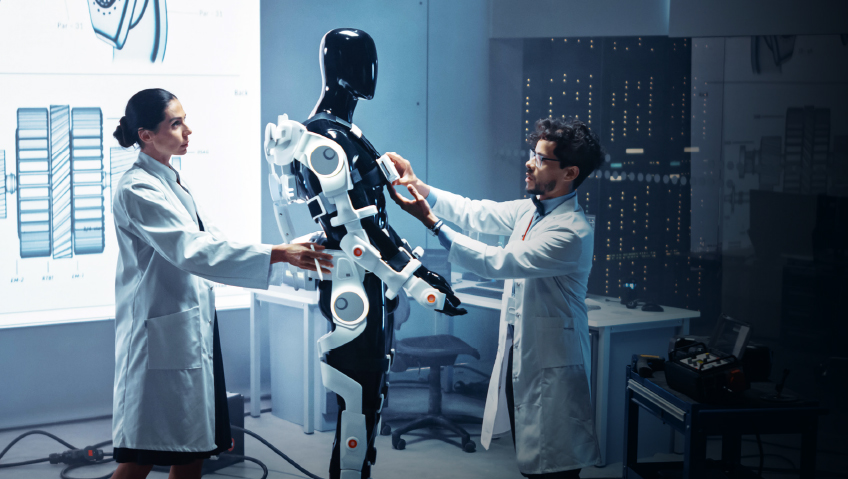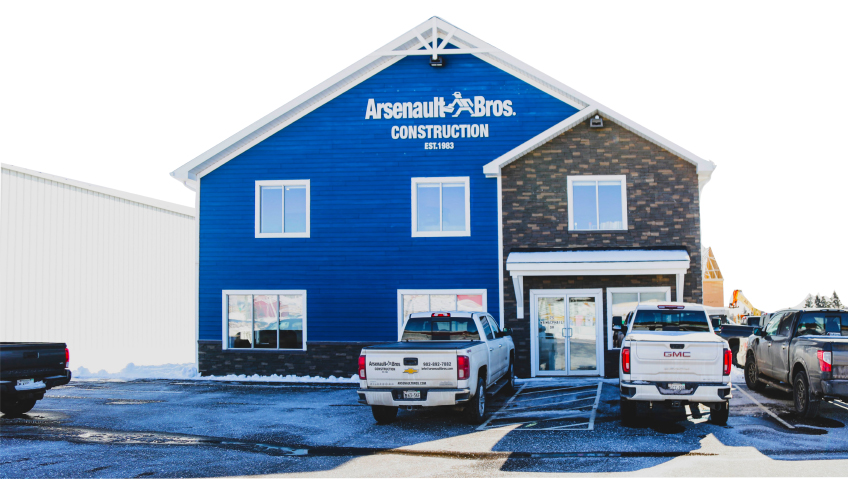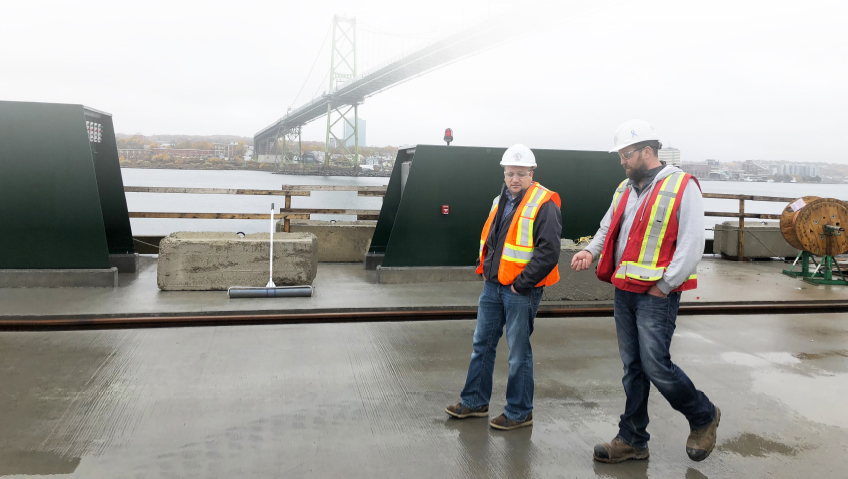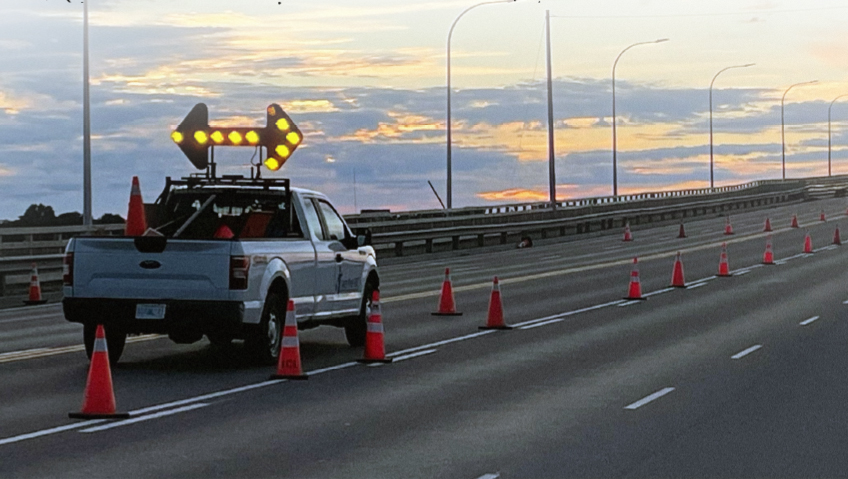There’s a lot going on at any given construction site. Even before a shovel hits the ground, there’s a great deal of lead-up and planning to design the building, and then the procurement organizing the equipment and workers. And when construction begins, there’s another world of variables and factors to plan for as a project takes shape in the real world.
And, like most industries across the board, technological advances are changing how construction sites operate.
One of the most fascinating developments is the field of wearables for safety and precision. Smart watches have been around for a few years, but there are other wearable items coming to market. Exoskeletons—sometimes called “bionic suits”—may play an increasing role as the construction workers age, for example.
These bionic suits, first developed by the military, comprise metallic frames that workers wear to provide support during strenuous tasks and help prevent injuries. Imagine workers that have near robotic strength, making lifted objects feel much lighter and easier to maneuver.
The frames are also set up with mechanical muscles that mimic a person’s skeletal and muscle structure, designed to move the way we do when we’re doing any physical job. In healthcare, the suits have been used to help with stroke recovery, so patients wearing them during physical therapy can regain limb strength training on a treadmill. More advanced suits can even help people who are paralyzed with walking and mobility.
New measuring tools have also been appearing and making an impact on construction sites for years. A tool that can now be commonly found is laser levels. By using light emitted from one end, laser levels create a visual chalk line that allows workers to quickly align and level areas as much as 100 feet away.
Some are also equipped with self-levelling sensors that boost accuracy. Ultimately, they shine a dot or a line (including a 360-degree one) for builders to lay out a site design faster and more accurately.
In an article for Electrical Contractor, Erik Charpentier, facilities instruments product manager of Fluke Corporation, talks about the advantages of these devices: “Laser distance meters make the user’s job faster and easier by performing a number of math calculations for the area, volume, addition and subtraction of measurements, minimums or maximums, Pythagoras calculations, and saving the results, eliminating transcription and reading errors.”
Construction tools are not limited to those found on the ground. Drones are now being put to work on construction sites. From above, they map out construction zones, cutting down on a significant amount of time by sweeping the topography of a particular site.
Also, from their vantage point, drones are positioned to do an overhead inventory of where all equipment is located on a site. Beyond these uses, drones can play a role in structure inspection, photography, and worker safety.
Another important tool is the video camera. An alarming stat from the National Equipment Register is that more than $300 million worth of construction equipment is stolen each year. Cameras providing constant surveillance help reduce instances of theft, and by adding artificial intelligence (AI) to the equation, cameras can identify suspicious activity around equipment on a site and alert security.
The planning stage of a project needs to be thorough and detailed before any construction takes place. But there is a real challenge in translating plans, models, and schematics into an actual building. That’s where building information modelling (BIM) can make a difference. This is a process that incorporates digital representations of buildings with 3D models that allow everyone involved to see the end goal they’re all working toward. In addition, changes can be made to the model in real time and sent to all team members for feedback and updates.
To make the most of this process, virtual reality (VR) can also be used to assess how a project is shaping up on a construction site.
A California Polytechnic State University case study looked at West Coast general contractors BNBuilders using VR to visualize the builder plans, correct any potential errors in real time, and keep costs down during construction. According to Senior Project Engineer Evan Horn, it’s clear that virtual reality models are especially helpful for the type of work being performed. “The model saves the project thousands of dollars because it eliminates the need for full-scale mock-ups of the workspaces.”
In addition, the authors say, “The model provides a detailed representation of what the workspaces will look like and have the specified equipment loaded into it. It gives the end user the opportunity to be involved with the design process and see if any component will be a problem in their day-to-day activities.”
AI is becoming more common in the world around us, from healthcare to cars, and the construction industry is well suited to benefit from AI because of the importance of data. Through all the steps that go into a building project, there are a series of decisions that take place from planning through execution. The power of data through AI can make the decision process more accurate and efficient.
While AI is continuing to evolve, it offers many potential benefits to the industry. One of the more intriguing benefits is how it can reduce waste and improve efficiency.
In an article by the consulting firm Deloitte, the company comments on the use of AI specifically in the construction and infrastructure industry: “The last five years have seen AI and advanced analytics gain traction in the industry. Investment in data analytics has the potential to realize value throughout the project lifecycle.”
The lifecycle includes design, bidding and financing; procurement and construction; operations and asset management; and business model reinvention and transformation.
As Deloitte explains, AI and advanced analytics provide real-time insights that help negotiations with suppliers through image-recognition algorithms delivering on-site measurements. You can avoid costly slowdowns due to errors in calculations of materials.
The technology can also manage the organizing of tasks and prediction of risks with real-time models for events such as localized storms. If you know ahead of time what’s coming, you can prevent damage to equipment, structures and materials. As American architect Frank Lloyd Wright famously said, “You can use an eraser on the drafting table or a sledgehammer on the construction site.”
Beyond efficiencies, AI can also be used to reduce risks and improve overall safety on construction sites. Cameras can maintain an unblinking eye on the site. When combined with AI they can detect unsafe behaviour and alert people to potential hazards before an accident occurs.
Not only does technology change how construction sites work, but changes to construction machinery are also having an impact. While many will walk past a site, see a bulldozer, and believe it’s basically the same machine they would have seen on a construction site some 30 or 40 years ago, that’s far from the reality.
Today’s machines are remarkably more sophisticated, precise and efficient. Forbes magazine notes how advances in machines are changing how construction gets done: “Increasingly modern machines and equipment are adding various sensors to help with overall function and operation of complicated and expensive machinery. These sensors can monitor a variety of different conditions relevant to construction such as temperature, engine condition and aspects of application of materials.”
The sensors also combine with AI to monitor the machine itself in real time. They provide data that are processed and used to predict potential problems, delays, and even potential malfunctions. This all means less downtime, deadlines achieved, and project costs saved.
In comparison to other industries, construction may have been a latecomer to incorporating technology. But innovations and advancements are now reshaping the industry, from planning to building. And as construction companies continue to invest in technology solutions, the industry will accelerate its productivity, become safer, more cost-effective, and better for us all.






